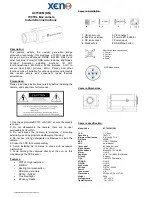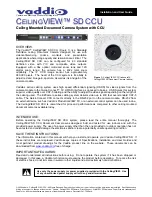
4 Image Acquisition
Acquisition Control
The acquisition control block takes care of the acquisition function. The
camera can only capture frames, when the acquisition has been started and is active (see
Section 4.2 for more information).
Frame Control
The frame control block takes care of the capturing of one or many frames and
burst of frames (see Section 4.3 for more information).
Exposure Control
The exposure control block takes care of the exposure time of a frame (see
Section 4.4 for more information).
Counter
The camera has four independent counters. They count events from a selectable
source (see Section 6.1 for more information about counter configuration and usage).
Timer
The camera has four independent timers. A timer delay and duration are configurable
and the timers are triggered by a selectable source (see Section 6.2 for more information
about timer configuration and usage).
Encoder
The camera has a configurable encoder block. A/B trigger signals are decoded to
generate internal trigger signals from selectable sources (see Chapter 7 for more
information about encoder configuration and usage).
Action
There are four actions, which can be used to trigger functions in the GigE camera, such
like aquisition and frame capture or counter and timer. Action commands can be
generated by the host application and are transmitted via GigE interface to the camera
with low latency and low jitter.
I/O Control
The I/O control unit manages physical camera inputs and outputs and LED. A
switch matrix within this block allows connecting internal status signals to the output
lines or LED. Status signals can come from the acquisition, frame or exposure control
block, also from timer or counter, or even input lines can be routed to an output. The
input lines can be used to control the acquisition, frame and/or exposure, also to start a
timer or count events with a counter (see Chapter 8 for more information).
Software Signal Pulse and User Output
The camera has user outputs, which can be set to 1 or
0 by software access, and a software signal pulse generator block (see Section 4.7). These
user outputs and signal pulses can be used to control camera functions by software
access, such like acquisition and frame capture or counter and timer.
Signal Routing
All these elements are connected to each other by the signal routing block. The
following sections show which signals are available and how they can be used in the
others blocks.
4.1.3
Image Acquisition, Frame and Exposure Control Parameters
Mainly the following commands/settings are involved in order to control and configure the
camera acquisition and frame capturing:
•
Acquisition Start and Stop Command
•
Acquisition Mode (Single Frame, Multi Frame, Continuous Frame)
•
Acquisition Frame Count
•
Acquisition Frame Burst Count
•
Acquisition Frame Rate
•
Exposure Mode (Timed, Trigger Controlled)
•
Exposure Time
24 of 143
MAN093 08/2021 V1.1
Summary of Contents for MV4 Series
Page 8: ...CONTENTS 8 of 143 MAN093 08 2021 V1 1 ...
Page 12: ...1 Preface 12 of 143 MAN093 08 2021 V1 1 ...
Page 40: ...4 Image Acquisition 40 of 143 MAN093 08 2021 V1 1 ...
Page 42: ...5 Exposure Control 42 of 143 MAN093 08 2021 V1 1 ...
Page 52: ...6 Counter Timer 52 of 143 MAN093 08 2021 V1 1 ...
Page 64: ...10 Image Format Control 64 of 143 MAN093 08 2021 V1 1 ...
Page 66: ...11 Frame Rate 66 of 143 MAN093 08 2021 V1 1 ...
Page 82: ...12 Pixel Data Processing 82 of 143 MAN093 08 2021 V1 1 ...
Page 92: ...12 Pixel Data Processing 92 of 143 MAN093 08 2021 V1 1 ...
Page 96: ...13 Precautions 96 of 143 MAN093 08 2021 V1 1 ...
Page 120: ...16 Troubleshooting 120 of 143 MAN093 08 2021 V1 1 ...
Page 126: ...19 Support and Repair 126 of 143 MAN093 08 2021 V1 1 ...
Page 128: ...20 References 128 of 143 MAN093 08 2021 V1 1 ...
















































